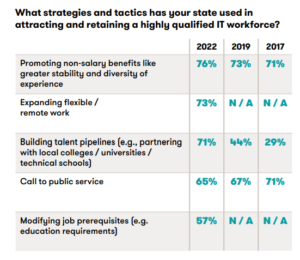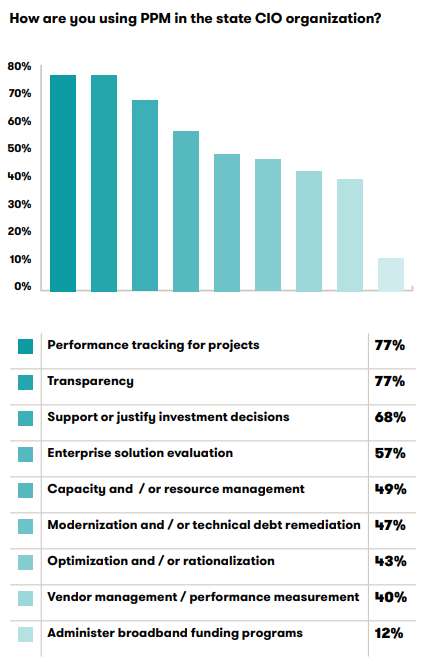

The National Association of State CIOs (NASCIO) and Guidehouse released the 13th annual survey of state chief information officers and found similar challenges and...
The workforce has risen as the top challenge for state chief information officers.
Like their federal brethren, state CIOs are struggling to find and keep employees with the right skill sets.
Doug Robinson, the executive director of the National Association of State CIOs (NASCIO), said concerns over recruiting, retention and resignations in the post-pandemic environment were wide spread among more than 50 respondents of the 13th annual survey of state CIOs.
“Regardless of the topic, whether it was legacy modernization, whether it was a discussion on post pandemic priorities, workforce challenges seem to be the first or second challenge,” Robinson said on Ask the CIO. “Our other survey on cyber, which was released the same conference in October, demonstrated the same type of pattern, a lot of conversations around the challenges of crisis in the cybersecurity workforce.”
Additionally, the respondents said the constraints of the workforce, both hiring and the skill sets they have, are as much or more of a constraint as funding typically is.
NASCIO found that CIOs are taking several steps to address the workforce challenge, including modernizing job titles, classifications and descriptions to more closely reflect the private sector, embracing remote work and flexible work schedules and recognizing more diverse teams are more productive teams and, most job seekers today place an emphasis on diversity, equity and inclusion.

“I think we’re just seeing something that perhaps has been there, but now has really been exposed for a variety of reasons — part of that retirement, part of that resignations and part of that is introducing new technologies into the state because of the pandemic,” Robinson said. “I think a good example is low code, no code that was nascent in a lot of states. Automation, robotics process automation, just automation, in general, machine learning were those also nascent and relatively at a small adoption level pre-pandemic, and then we just seen this big jump, and the states just didn’t have the skills to do that. So I think that it’s really exposed to a number of things.”
Graeme Finely, a partner with Guidehouse, which co-produced the survey with NASCIO, said one big change the survey revealed is the CIOs are more comfortable with the remote work aspect. He said telework or remote work was not well received in most states pre-pandemic.
“Geographic location is another one which I find particularly interesting. A few years ago if you were to look at state IT workforces, most people will located pretty much at the state capitol because that’s where the state agencies primarily were,” he said. “But all of a sudden, by necessity, people are going remote. That meant that states can now hire in a much more geographically diverse, so it’s been an almost an economic development story.”
The broader acceptance of remote work also is helping CIOs with recruitment. While they can’t usually compete with the private sector on salary, respondents said emphasizing public service and other non-salary benefits are key tactics.

Robinson said remote work didn’t even register as a recruitment tactic in surveys from 2019 or 2017.
Along with workforce, state CIOs said their roles and the business models their agencies use have evolved once again.
Finely said the ability for CIOs to manage vendor relationships and to manage customer relationships has become just as, if not more, important than the ability to manage technology.
“A lot of the re-skilling it’s less about are you going from COBOL to some low code, no code solution. It’s going from a technology heavy role where they were really dealing with IT to now most of their job is dealing with people. That’s a different skill set altogether,” he said.
Robinson added several CIOs said they are turning to managed services and using staff augmentation to backfill some of those roles especially in cybersecurity.
The survey demonstrated CIOs are looking for a new operating model, which is much more public private collaboration and less of an owner-operator model.

Finely said each state is taking a different approach to managing technology making their operating models slight different, but a common trend is the use of portfolio management tools.
He said the CIO organization uses these systems to better understand what is happening across the different IT projects.
“How they use that information varies a lot, depending on the nature of the CIO organization. In some cases, it’s mostly a reporting engine. In others, it helps inform budgeting. And for others, there’s either a policy or an architecture of the CIO, where they get to be potentially a de facto decision maker,” Finely said. “In other areas, they’re actually driving the strategy and they’re actually leading many of these projects. So how actively the information is used to manage versus just inform and report depends on the organization of the CIO.”

CIOs say the portfolio management approach is helping them gain better enterprise visibility, which has been lacking for years.
Robinson said this also means CIOs are helping to drive investment decisions as well as consolidation initiatives.
“We hear anecdotes of a state having 121 case management systems. While you clearly don’t need 121 case management systems, you got to figure out how to rationalize that. I think that portfolio management approach gives us a chance to be able to identify that diversity and complexity, and then make their business case to appropriators and to budget people and say, ‘we’ve got an enterprise solution for you know,’” he said. “But without having that baseline data, without knowing the applications in the agencies, they can’t make wise decisions. I think the states that have pursued that are going to be better off and making better investments in the future.”
Copyright © 2025 Federal News Network. All rights reserved. This website is not intended for users located within the European Economic Area.
Jason Miller is executive editor of Federal News Network and directs news coverage on the people, policy and programs of the federal government.
Follow @jmillerWFED

